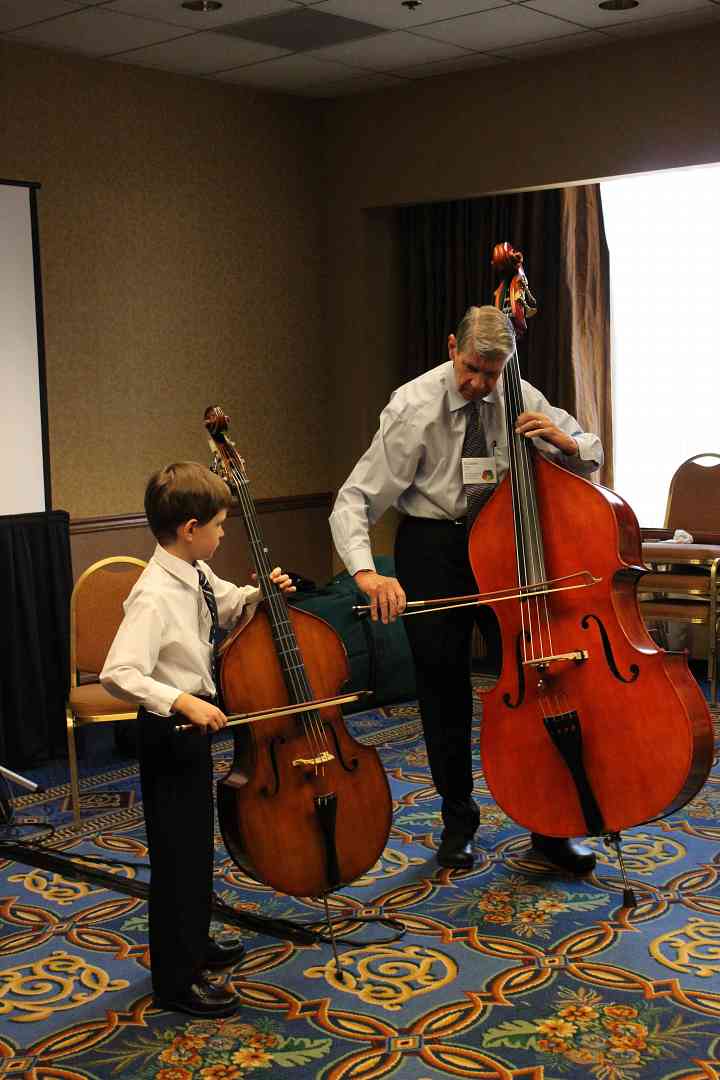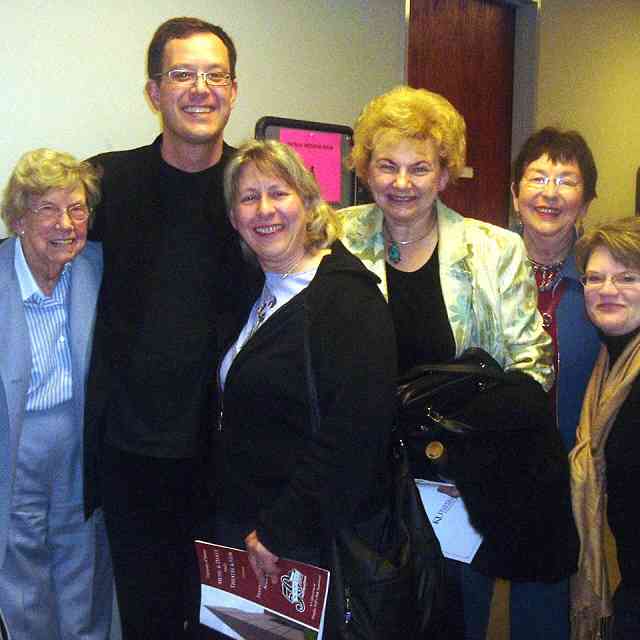
Luke Montzka in a bass master class with Daniel Swaim at the 2014 SAA Conference.
Once there was a wonderful orchestra. It had mostly violinists divided up into two sections, but also plentiful violists and cellists. Each member had thorough training, since they had all started at a very young age, and they could technically lead themselves in and out of difficult spots so well that all the conductor had to do was to steer them toward heightened architecture and deeper phrasing. The program was full of pulsing, vibrant rhythms, beautiful modal melodies, and harmonies of great sensitivity.
But there was something terribly missing. There were no bassists, and the whole orchestra was so involved in the task of bringing this music even more to life that they never even noticed this.
Well, I was there, and the institute director also knew that something was missing, and had asked me to come and help. So I had the pleasure, as someone about to dive into a perfectly still swimming pool, or the first one to break the surface of a fresh jar of peanut butter, to sneak onto the back of the stage, set up my bass, arrange my music, and to begin playing. In the next thirty seconds, the head of every violist and every cellist turned to look behind them to see what had transpired in the back of their sections. There was a bassist, adding the depth of sound and the strength of pulse that enables a string orchestra to absolutely ring!
If you listen to an orchestra of violins, violas, and cellos, and suddenly a bassist appears, you will be impressed too, and never want to return to an orchestra without bass. So how about now adding bass to your school’s program? Allow me to lead you through the process. In my tenth year as an SAA Register Bass Teacher Trainer I have finally come to understand that it is the chicken that comes first, not the egg. Just like with the other Suzuki instruments, you must have bass teachers in place before you can properly hatch a nice supply of bass students.
Locating a Teacher
Bass Training
There are multiple Suzuki Bass training opportunities for summer 2015.
Bass Unit 1
June 21-28, Colorado Suzuki Institute
Beaver Creek, CO. Virginia Dixon, Teacher Trainer
Bass Unit 1
July 19-26—Studio of Daniel Swaim
Chandler, AZ. Daniel Swaim, Teacher Trainer
Bass Unit 2
July 26-August 1—American Suzuki Institute
Stevens Point, WI. Virginia Dixon, Teacher Trainer
Bass Unit 4
August 3-8—Japan-Seattle Suzuki Institute
Seattle, WA. Virginia Dixon, Teacher Trainer
The best way to find a bass teacher is to see if you can locate one who has taken teacher training. This can be done quickly on the SAA website. But alas, what if your program is in a location (and there are many) where you are not yet lucky enough to find such a person?
Next best is to find a really strong player who is willing to do training. Who are the bassists in your orchestra who could be metamorphosed into wonderful Suzuki teachers? Are there music students in area colleges and universities who now face creating a life in the music profession who could add Suzuki teaching to their mix of professional activities? If you have institutional funds to invest in this, it will encourage someone along the way into training, especially if the person is yet to become established.
A simple scheme for encouraging training that I have seen is to give a raise in salary per Suzuki course registered. Even with a small teaching load, this raise can pay for the cost of one training course in one year. After that first year, it becomes all income! I always very much appreciated employers who implemented this policy. It is a win-win situation for the school and for the teachers and an extremely fair way to award raises. Once training is completed, this policy could apply to repeat courses, Suzuki conferences, and other professional activities that support growth.
If you cannot locate a bassist who is willing and able to teach Suzuki, you can convince a cello or violin teacher to do some bass training. Even if they cannot develop the skill to pass the audition, I welcome them to audit my courses. If the teacher is already skilled at building up healthy and beautiful playing on their instrument, they will be even more conscientious about being on their toes with bass instruction. Fortunately, since the size of bass training classes is smaller than violin classes, I can welcome all instrumentalists into my training classes regardless of status to play with the class, as it can be a great resource for the entire group. Upper string players bring the rest of us new insights and we can inspire our non-bassist colleagues’ playing, as well. It can be a win-win situation.
Finding Bass Students
There may be potential bass students already lurking in and around you program. Here are some of the sources that I have found over the years:
-
We Suzuki teachers love younger siblings. But there are also older siblings who for various reasons never started to play. Even if the entire family began on violin we have seen the wisdom of each child eventually playing his very own separate instrument to lessen some of the inevitable comparisons that arise between siblings.
-
Children who display a great predominance of gross motor skill may be extremely well suited for bass playing. One does better at bass already having a sense of how to apply athletic energy.
-
If a school has a waiting list, the bass teacher can call this list to inquire if families would like to start Suzuki instruction immediately on the bass without waiting. The most thriving Suzuki bass programs on the North American continent have used this method.
-
Bass is a wonderful second instrument for the older child who would like to branch into other instruments or styles. It has commonality with cello, guitar, and bass guitar and is indispensable in styles of music that seldom use cello, namely jazz, bluegrass, and tango and it is key to understanding the importance of bass lines. It is a logical step to the study of early instruments such as the viola da gamba and violone.
-
There may be students in your school who already play an instrument, but feel for some reason as if it is a stepping stone to another.
-
Probably, and most importantly, there are those of us who love deep sound, and that very often goes for their families as well, be it environmental or genetic. If a child has expressed a preference for the bass, I believe that they should be allowed to switch to bass.
Bringing Plans to Fruition
Even though plans may be in place for this year, it is not too early to strategize for the following fall semester. If a person must be trained, then it can happen this summer before the start of the fall semester. Also, it is important that families in your school have many opportunities to hear about an upcoming bass program. It can be done in newsletters, mailings, and as announcements. A bassist, preferably your future bass teacher, can be invited to demonstrate for your orchestra, SECE and group classes, and to present at parent activities. Do invite your potential teacher to be a ringer for your orchestra for extra visibility and audibility.
I once had the opportunity to work along with the orchestra conductor in a preparatory music program to create a scholarship for existing bassists who had started in the public schools. Together we approached them, letting the orchestra directors know that we would offer a semester of orchestra if the child were enrolled in just ten bass lessons. Since the orchestra was in place and the conductor already hired, adding a bassist or two would add no additional cost to the program. We had six or seven students go through this program, and most dropped away. But the one who stayed paid tuition for seven years until she graduated from high school and went on as a music major with one of the country’s most sought after bass teachers, and is now teaching strings in the schools. I am guessing that this little scholarship, which cost the school no additional money, made much more for the school than many other fundraising activities!
Acquiring the Instruments
One last consideration is the availability of little instruments and bows. If you cannot, at first, justify the investment of basses, then cellos can easily be converted into cello-basses by tuning them as basses one octave higher than the traditional range. The C string is hardest to bring up to the bass E and must unfortunately be replaced once a year. Flat-wound electric bass strings will play in the authentic bass range, but are bulkier for small hands. I regularly show my trainees how to increase a student’s endurance, not only for the strings, but for the bow, for which you can use a cello bow that is one size smaller than the cello being used and still get a healthy sound.
But slowly the instruments are evolving. Some bass luthiers will rent over long distances. If a local luthier already does considerable work for the school, he can be coaxed into supplying little basses. Presently there are basses as small as one-sixteenth size, and some very nice little German bows. I am not as fond of many of the tiny French bows and still prefer a cello bow for the very start.So make it a goal to work toward bass as an instrument in your school! You will be richly rewarded by the addition of its lovely low sound.








